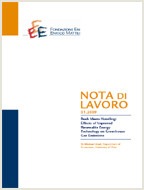Energy from Waste: Generation Potential and Mitigation Opportunity

03.04.2014
Francesco Bosello, Lorenza Campagnolo, Fabio Eboli, Ramiro Parrado
C68, E27, Q42, Q43, Q54
Climate Change, Mitigation, Energy From Waste
Climate Change and Sustainable Development
Carlo Carraro
The present research proposes a macroeconomic assessment of the role of waste incineration with energy recovery (WtE) and controlled landfill biogas to electricity generation and their potential contribution to a CO2 emission reduction policy, within a recursive-dynamic computable general equilibrium model. From the modelling viewpoint, introducing these energy sectors in such a framework required both the extension of the GTAP7 database and the improvement of the ICES production nested function. We focus our analysis on Italy as a signatory of the GHG reduction commitment of 20% by 2020 wrt 1990 levels proposed by the European Community; the rest of the world is represented by 21 geo-political countries/regions. It is shown that albeit in the near future WtE and landfill biogas will continue to represent a limited share of energy inputs in electricity sector (in Italy, around 2% for WtE and 0.6% for biogas in 2020) they could play a role in a mitigation policy context. The GDP cost of the EU emission reduction target for the Italian economy can indeed be reduced by 1% when the two energy generating options are available. In absolute terms, this translates into an annuitized value of 87-122 million €.
***
Suggested citation: Bosello, F., L. Campagnolo, F. Eboli, R. Parrado, ‘Energy from Waste: Generation Potential and Mitigation Opportunity’ published in Environmental Economics and Policy Studies, October 2012, Volume 14, Issue 4, pp 403-420, DOI 10.1007/s10018-012-0043-5.
